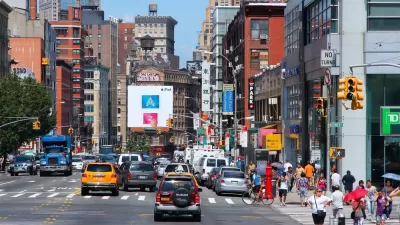Congestion management using parking strategies would be more politically palatable while delivering significant outcomes.

Jay Primus outlines a three-pronged approach for New York to tackle congestion through parking-related measures. The first part would prohibit monthly parking and instead require parking be offered in hourly increments, as a way to encourage people to think about each driving trip they make.
The second strategy, increasing the parking tax, would ease congestion and provide additional benefits, says Primus:
This is a straightforward, efficient and sensible way to gently discourage driving while helping to finance public transit improvements. As those with higher incomes are more likely to drive into the city, making parking cost a little more to subsidize public transit will improve equity.
The third part would require garages and lot operators to offer lower off-peak parking prices. This is another way to encourage drivers to consider their trips and shift their travel to off-peak hours, which would then spread vehicle travel out over time. This strategy, adds Primus, also is more politically acceptable:
The magic of this approach is that it is tantamount to a peak period surcharge but framed as an off-peak discount — no one (other than economists) likes peak period surcharges, but everyone loves a discount. The effect is the same but the political viability is crucially different.
Primus suggests that these strategies be used in conjunction with other congestion management tactics, including parking meter pricing, management of residential street parking, and transportation subsidies for employees instead of parking subsidies.
He also urges New York to adopt these strategies in order for it to be a leader in forward-thinking congestion management. “Cities are looking for ways to be smart — and this no-tech, no-cost, data-free and politically feasible approach to congestion management could be the smart way forward,” says Primus.
FULL STORY: A Better Way to Get New York’s Traffic Moving

Planetizen Federal Action Tracker
A weekly monitor of how Trump’s orders and actions are impacting planners and planning in America.

San Francisco's School District Spent $105M To Build Affordable Housing for Teachers — And That's Just the Beginning
SFUSD joins a growing list of school districts using their land holdings to address housing affordability challenges faced by their own employees.

The Tiny, Adorable $7,000 Car Turning Japan Onto EVs
The single seat Mibot charges from a regular plug as quickly as an iPad, and is about half the price of an average EV.

As Trump Phases Out FEMA, Is It Time to Flee the Floodplains?
With less federal funding available for disaster relief efforts, the need to relocate at-risk communities is more urgent than ever.

With Protected Lanes, 460% More People Commute by Bike
For those needing more ammo, more data proving what we already knew is here.

In More Metros Than You’d Think, Suburbs are Now More Expensive Than the City
If you're moving to the burbs to save on square footage, data shows you should think again.
Urban Design for Planners 1: Software Tools
This six-course series explores essential urban design concepts using open source software and equips planners with the tools they need to participate fully in the urban design process.
Planning for Universal Design
Learn the tools for implementing Universal Design in planning regulations.
Smith Gee Studio
City of Charlotte
City of Camden Redevelopment Agency
City of Astoria
Transportation Research & Education Center (TREC) at Portland State University
US High Speed Rail Association
City of Camden Redevelopment Agency
Municipality of Princeton (NJ)




























